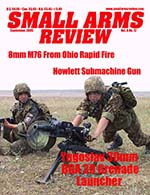By James L. Ballou
In 1931, Japan invaded and occupied Manchuria and set up a puppet government lead by the last Emperor of China. In July 1937, they moved into Southern China where they encountered opposition from various warlords who had armed themselves with weapons from the world market including Belgium, Germany and United States.
It was common practice for the Japanese to copy the designs of weapons from other nations. Their ingenuity is manifested in the way they copied these other designs. It is clear that the Type 96 and 99 Arisaka rifles are of the Mauser design but they are not exact copies. The Arisaka bolt is one of the simplest to disassemble of any Mauser type rifle and was ideally suited to be used by the peasant soldiers.
Most of their heavy machine guns have as their origin, Hotchkiss designs. These included the Model 1897, Taisho 3 and Type 92 heavy machine guns. Even with low-grade steel, their infantry weapons functioned reliably and safely.
The first hint of a Japanese BAR came from an obscure US Technical Manual TM 30-480 titled. “Handbook on Japanese Forces,” dated September 21, 1942. On page 94, they state, “In the Philippines the Japanese were reported to have used an automatic rifle made in Belgium which is basically of the same design and mechanism as the Browning Automatic Rifle. The captured weapon examined was a 7.7-mm caliber rifle with a 21” barrel and weighed 20 1/2 pounds.... bearing the following identification;
“Fabrique National d’Armes de Guerre
Herstal, Belgique
Browning Patented 1932.”
A second clue came from the Colt Collection housed in The Museum of Connecticut History, which is part of the State Library. The evidence came in the form of an FN Model 30, serial No. 4032. The tag was labeled 6.5x51SR Japanese; however the markings on the barrel read “7.9M B.Blindee.”
What is the origin of the Japanese FN BAR’s? Where and when did the Japanese acquire them as they all seem to be FN Belgian Model 30’s and FNDs? More than likely they were in 7.92x57M (Mauser) rather than the Japanese caliber. Professor Edwin F. Libby of the University of Maine, a noted historian in Japanese weapons, shed some light on the subject when he said that it would be far easier for the Japanese to capture and use the FNs from the Chinese, who had them in abundance, rather than manufacturing or purchasing them.
There is some photographic evidence that requires some discussion. The first is a “too pristine” FN Model 30 missing its rear sight. These photographs clearly show that the top of the receiver was milled and refinished. Prof. Libby supplied the translation of the Japanese characters on the top of the receiver. The Kanji markings indicate it was from the Yokosuka (Navel) Arsenal (similar to the former MoD Pattern Room in England), study No. 12 in their collection. An accompanying document indicated that it had been “liberated” with the sanction of the American “Shogun” General Douglas MacArthur. The elaborate and pristine blueing infers that the gun had some type of collection status rather than a battlefield pick-up.
The second piece of evidence is from the United States Archives, Signal Corps photograph #111-SC-229351. Notations on the back of the original photo state that this FND was captured by the Chinese 98th Division from the Japanese 148th Regiment near Leng Sui Kou, China with the notation, “Browning 1938 LMG Left hand view, China 7/29/44.” This intriguing photographic evidence shows a prewar manufactured FND on a woven mat “somewhere” in China. It is more than likely that this captured BAR was in 7.92x57mm Mauser. Research indicates the Chinese Government bought 3,148 FN BARs; mostly Model 30s in 7.92x57M.
The Japanese Imperial Forces, anointed by the Emperor, did not make it a practice to use the weapons of a dead enemy. However, they were not foolish enough to dismiss the design of efficient weapons. Often, they would copy and produce their own version of those weapons. A prime example would be the Lewis LMG, Type 92 produced at the Yokosuka Arsenal.
One of the reasons for the failure of the Japanese Empire was their weapon designs were rooted in the 19th Century. They did not aggressively pursue more efficient trends such as the BAR and SMG until near the end of the war, which was too little and too late.
I would like to thank Prof. Edwin Libby and Howard L. Miller, Curator of the Museum of Connecticut History, for their kindness and generosity in providing material for this article.
This article first appeared in Small Arms Review V8N12 (September 2005) |
| SUBSCRIBER COMMENT AREA |
Comments have not been generated for this article.








